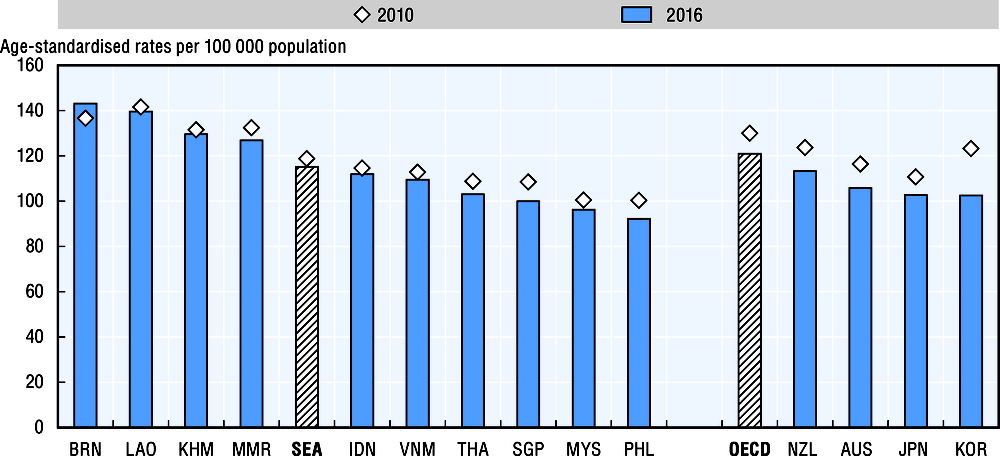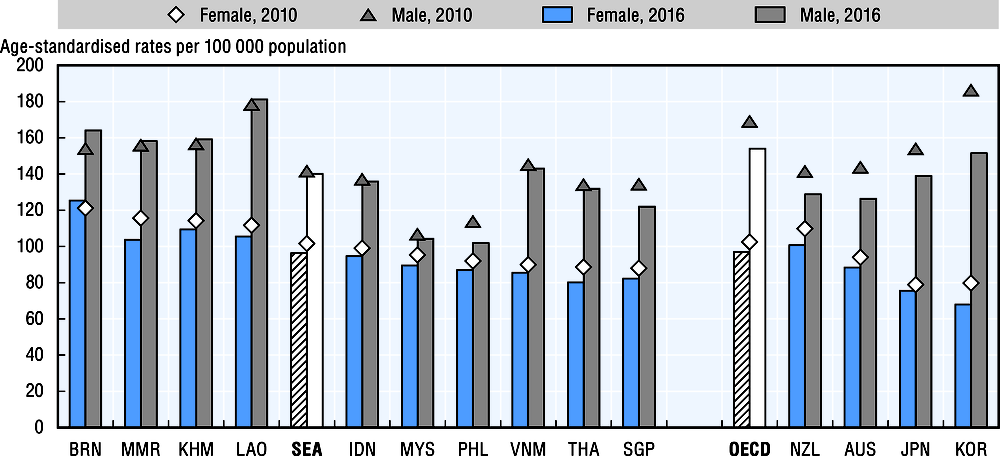Chapter 7 discusses three public service sectors – healthcare, education and justice. The OECD Serving Citizens Framework identifies access, responsiveness, and quality of services as factors that matter most to citizens. For each of these three dimensions, key indicators are presented where sufficient data are available for the SEA countries; this section focuses on quality in healthcare. This indicator can be assessed at least partly by looking at the mortality rates for the main causes of death, one of which is cancer.
In OECD countries, some of the most frequent and serious health problems include cardiovascular disease and different types of cancer. In SEA countries, a high burden of communicable diseases raises concerns that countries have not been effective in eradicating vaccine-preventable diseases despite government policies and interventions. There has also been an increase in non-communicable diseases (NCD) and NCD-related deaths in Asia due to behavioural risk factors such as increased tobacco use, alcohol consumption and inadequate physical activity. The importance of having a high-quality health care system is evident; while more efforts can go into prevention, health care systems have a major role to play in the early detection of health problems and in providing effective and timely treatments when they are diagnosed.
Cancer is well established as a leading cause of death globally. As prevalence of cancer rises in Asia, either due to medical advancements or increasing awareness, the economic toll on patients and families remains a challenge. Lengthy treatments can impose financial strains and have a worse effect on citizens in low- and middle-income countries, where social safety nets such as health insurance are often limited. Thus, understanding living standards and types of medical assistance available in countries can be useful to analyse mortality rates, as an indication of the existing quality of health care services.
Estimated cancer mortality rates therefore constitute one indicator of the quality of health care available in countries. In Asia, the most common cancers in men include lung, stomach and liver cancers; in women, breast, lung and cervical cancers. Across SEA countries, the average estimated cancer mortality rate is 115 deaths per 100 000 population, slightly lower than the OECD average of 121 deaths. Estimated cancer mortality rates vary widely in the region however. The SEA countries with the highest incidence are Brunei Darussalam (143 deaths per 100 000 population) and Lao PDR (140 per 100 000) in 2016. Countries with the lowest estimated cancer mortality for the same year are Malaysia (96 per 100 000) and the Philippines (92 deaths per 100 000).
Across all SEA and OECD countries, estimated cancer mortality rates have decreased from 2010 to 2016, except in Brunei Darussalam. In SEA, the average rate decreased from 119 to 115 deaths per 100 000 population during this period.
Estimated cancer mortality rates by gender are generally higher for males than females; though once again there is a large variation across SEA countries. In 2016, Lao PDR was the country with the highest estimated cancer mortality rate for males (181 deaths per 100 000 population) – the Philippines had the lowest, recording 102 deaths per 100 000 population for males in the same year. For women in 2016, there were estimated to have been 125 deaths per 100 000 population in Brunei Darussalam; in stark contrast, estimates for Thailand are 80 deaths per 100 000 population. Despite the general decrease in estimated mortality rates for both males and females in OECD and SEA countries from 2010 to 2016, early diagnosis remains key to reducing mortality rates. Access to cancer diagnosis and care thus needs to be actively promoted through public health interventions or wider health coverage (OECD, 2013).


